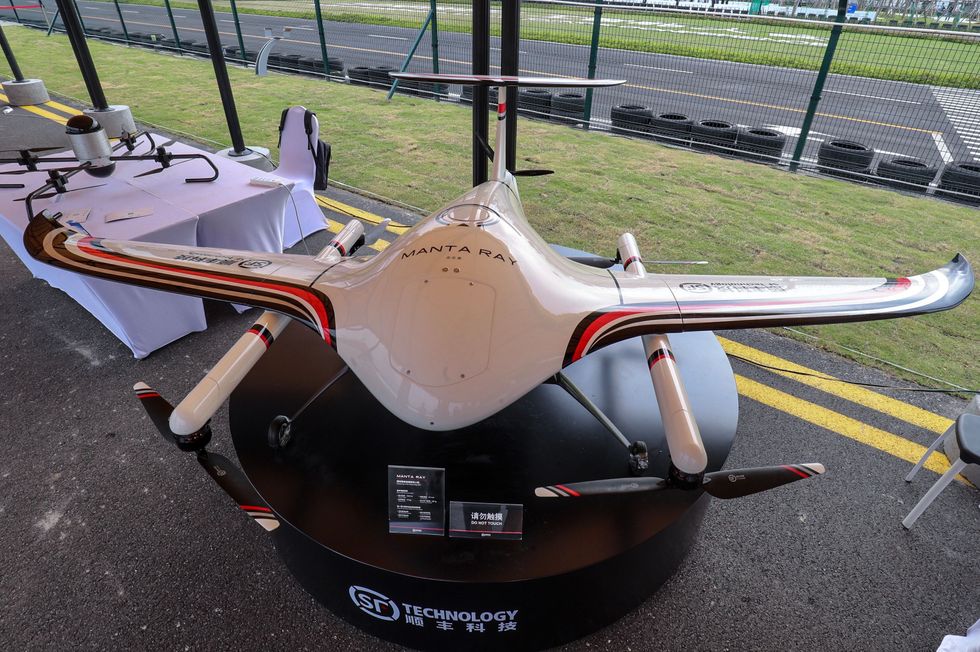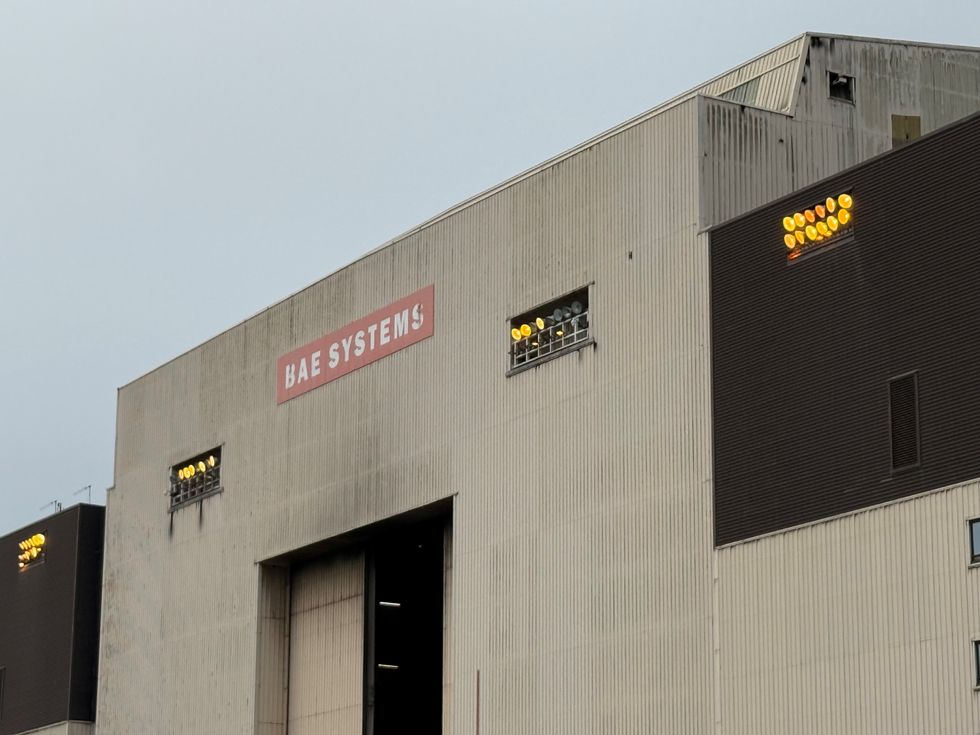The US is understood to have started developing "underwater drones" amid a potential threat of war with China.
A secretive underwater drone has been spotted at a California naval base by an eagle-eyed Google Maps user, revealing the latest development in submarine warfare technology.
The distinctive silhouette of Northrop Grumman's Manta Ray, named after the sea creature that inspired its design, was identified at Port Hueneme naval base.
The discovery has highlighted the latest Western advancement in an ongoing race between the US and Russia to expand drone warfare capabilities beneath the waves.

The evolution of drone warfare has shifted since its deployment in Ukraine's conflict with Russia.
At first, modified consumer drones were used to drop grenades through tank hatches, challenging multi-million dollar military equipment.
This innovation soon expanded to naval warfare, where uncrewed vessels proved devastating against Russia's Black Sea Fleet, forcing it to retreat to home ports.
This success has prompted the world's leading navies to explore unmanned submarine technology as the next frontier as both Russia and China are actively developing their own submarine drone capabilities.
LATEST DEVELOPMENTS:
- 'Prisoner' freed from Syrian prison by CNN was 'regime torturer' with 'fake identity'
- Justin Trudeau on 'brink of resigning' after Deputy PM quits following Trump's tariff warning
- Assad's rotten regime is over but I know the danger lurking in the shadows - Major General Tim Cross
Moscow has announced plans to acquire 30 Poseidon drones, torpedo-shaped robotic submarines that reportedly can reach speeds of 100 knots.
Russian sources have claimed that these vessels have a nuclear propulsion system with a 6,200-mile range and can carry nuclear warheads.
Likewise, China has started to expand its fleet of uncrewed sea vessels, including submarine variants amid growing concerns over threats to critical underwater infrastructure.
The Manta Ray is designed primarily for intelligence gathering and protecting undersea infrastructure, and can anchor itself to the sea floor and enter a "hibernating" low-power mode.
Manufacturers have even claimed that it is capable of travelling more than 10,000 nautical miles whilst carrying a 10-ton payload.
Unlike Russian counterparts, US underwater drones are currently not armed, focusing instead on detection and surveillance missions.

The protection of underwater infrastructure has become increasingly critical following mysterious incidents of alleged sabotage to underwater cables and Nord Stream gas pipes.
Admiral Lisa Franchetti, chief of naval operations, emphasised this priority, saying: "Unmanned systems have an enormous potential to multiply our combat power."
One key challenge has remained the difficulty in detecting undersea sabotage, making communication between underwater craft and surface vessels particularly crucial.
Currently, Britain's BAE Systems is testing its own underwater drone called the Herne off the British coast.
The 40-foot tubular vessel, more conventionally submarine-shaped than the Manta Ray, has demonstrated impressive capabilities in trials as, during one test, the Herne successfully identified two UK naval vessels at sea level before submerging undetected.
With the Royal Navy's reduced size compared to its historical strength, these unmanned vessels are expected to serve as crucial force multipliers.
from GB News https://ift.tt/rYlpeOR
The US is understood to have started developing "underwater drones" amid a potential threat of war with China.
A secretive underwater drone has been spotted at a California naval base by an eagle-eyed Google Maps user, revealing the latest development in submarine warfare technology.
The distinctive silhouette of Northrop Grumman's Manta Ray, named after the sea creature that inspired its design, was identified at Port Hueneme naval base.
The discovery has highlighted the latest Western advancement in an ongoing race between the US and Russia to expand drone warfare capabilities beneath the waves.

The evolution of drone warfare has shifted since its deployment in Ukraine's conflict with Russia.
At first, modified consumer drones were used to drop grenades through tank hatches, challenging multi-million dollar military equipment.
This innovation soon expanded to naval warfare, where uncrewed vessels proved devastating against Russia's Black Sea Fleet, forcing it to retreat to home ports.
This success has prompted the world's leading navies to explore unmanned submarine technology as the next frontier as both Russia and China are actively developing their own submarine drone capabilities.
LATEST DEVELOPMENTS:
- 'Prisoner' freed from Syrian prison by CNN was 'regime torturer' with 'fake identity'
- Justin Trudeau on 'brink of resigning' after Deputy PM quits following Trump's tariff warning
- Assad's rotten regime is over but I know the danger lurking in the shadows - Major General Tim Cross
Moscow has announced plans to acquire 30 Poseidon drones, torpedo-shaped robotic submarines that reportedly can reach speeds of 100 knots.
Russian sources have claimed that these vessels have a nuclear propulsion system with a 6,200-mile range and can carry nuclear warheads.
Likewise, China has started to expand its fleet of uncrewed sea vessels, including submarine variants amid growing concerns over threats to critical underwater infrastructure.
The Manta Ray is designed primarily for intelligence gathering and protecting undersea infrastructure, and can anchor itself to the sea floor and enter a "hibernating" low-power mode.
Manufacturers have even claimed that it is capable of travelling more than 10,000 nautical miles whilst carrying a 10-ton payload.
Unlike Russian counterparts, US underwater drones are currently not armed, focusing instead on detection and surveillance missions.

The protection of underwater infrastructure has become increasingly critical following mysterious incidents of alleged sabotage to underwater cables and Nord Stream gas pipes.
Admiral Lisa Franchetti, chief of naval operations, emphasised this priority, saying: "Unmanned systems have an enormous potential to multiply our combat power."
One key challenge has remained the difficulty in detecting undersea sabotage, making communication between underwater craft and surface vessels particularly crucial.
Currently, Britain's BAE Systems is testing its own underwater drone called the Herne off the British coast.
The 40-foot tubular vessel, more conventionally submarine-shaped than the Manta Ray, has demonstrated impressive capabilities in trials as, during one test, the Herne successfully identified two UK naval vessels at sea level before submerging undetected.
With the Royal Navy's reduced size compared to its historical strength, these unmanned vessels are expected to serve as crucial force multipliers.




0 Comments
Don't share any link